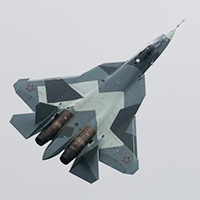Russia to receive 5th gen fighters this year

The Russian Air Force is set to receive the first batch of Sukhoi T-50 PAK FA jet fighters this year amid its strained business relationship with co-developer India.
Compared with the aircraft’s previous version, the variant has been fitted with a number of new features, according to the manufacturer.
Despite this, Russia will need to cope with the increasing criticism voiced by India, which is partnering with Moscow on developing the aircraft, amid concerns over delivery delays and technical shortfalls of the program.
Local analysts say that the bilateral cooperation on the program has produced a sense of disenchantment by India’s military circles.
While the program has been “announced with a great deal of promise for the overall Indo-Russian defense cooperation,” the fighter jet project “is currently confronted with a myriad of problems. With India already having paid US $295 million for the preliminary design and development costs, Russian unwillingness to share design information on the aircraft is not being received well in New Delhi,” said Monika Chansoria, senior fellow at the Centre for Land Warfare Studies think tank in New Delhi.
The T-50 is to serve as the basis for developing the Fifth Generation Fighter Aircraft program, which will be supplied to the Indian Air Force. In 2007, Moscow and New Delhi signed an agreement to jointly develop the fighter jet, following which Russia’s state-owned Rosoboronexport and Sukhoi, and India’s state-run Hindustan Aeronautics Limited, signed a preliminary design development deal. The total worth of design, research and development works has been estimated at more than $10 billion.
Meanwhile, the capabilities added to the new variant of the stealth fighter include a new avionics suite that integrates the electronic pilot functionality, and an advanced phased-array antenna radar, according to Russia’s state-run United Aircraft Corp.
With the new features, United Aircraft says it is aiming to significantly decrease pilot load, and enable data exchange in real time, not only with ground-based control, but also within the flight group, according to information obtained by local news agency ITAR-TASS.
The fifth-generation fighter jets will be made at the plant in Komsomolsk-on-Amur, a subsidiary of the Russian group. The aircraft is to be enabled with a maximum speed of 1,516 mph.
“Following repeated demands by India, the Russians finally agreed to carry out a technology demonstration flight of the prototype aircraft in June 2014, which, shockingly, caught fire at the end of the test flight while landing at the Zhukovsky test center near Moscow,” Chansoria said. “What added to the controversy … was Russia’s refusal to share any details of this failure, to the extent that a technical evaluation team of the Indian Air Force that reportedly was present at the site was refused access to inspect the damaged platform.”
The T-50 is intended as a successor to the Russian military’s fourth-generation Sukhoi Su-27 and Mikoyan MiG-29 fighters, and a competitor to the F-22 Raptor and F-35 aircraft. The deliveries of the aircraft have been significantly postponed, as in 2010, Russia’s then-Prime Minister Vladimir Putin said the first batch of the fighter jet was expected to be supplied to the country’s Air Force in 2013.
The analyst said that the “repeated technical delays on the project are prompting a debate within India” whether the country “can afford to wait for another decade to induct the fighter into its forces.”
By 2020, the Russian Air Force will have acquired 55 T-50s, Vladislav Goncharenko, the deputy head of the military aviation programs department at United Aircraft, said Dec. 15, as reported by ITAR-TASS.
Under the plan, the Russian Air Force this year will obtain 126 new aircraft and 88 helicopters as part of the country’s military modernization program.